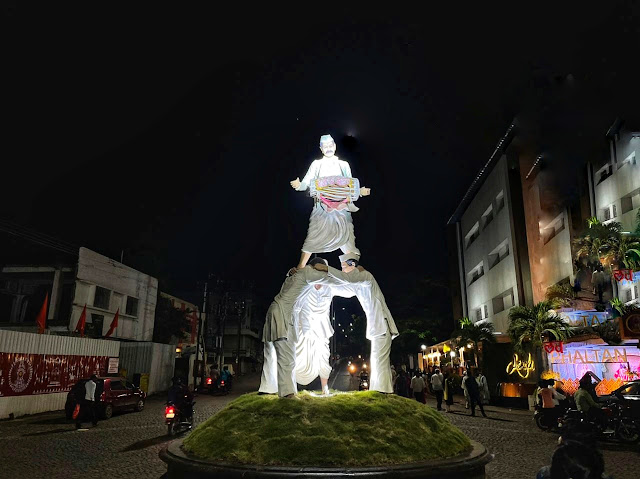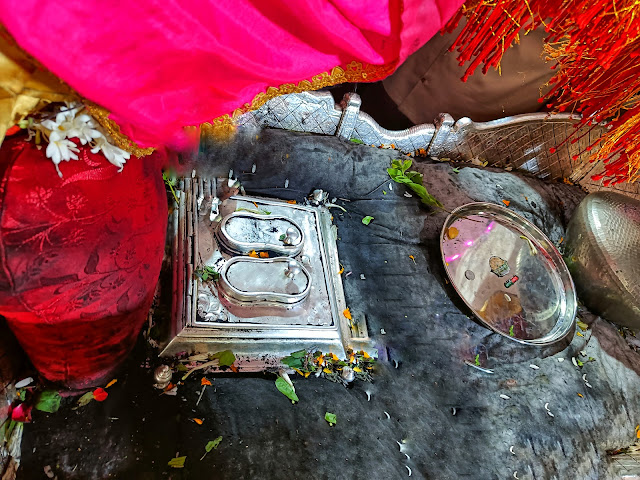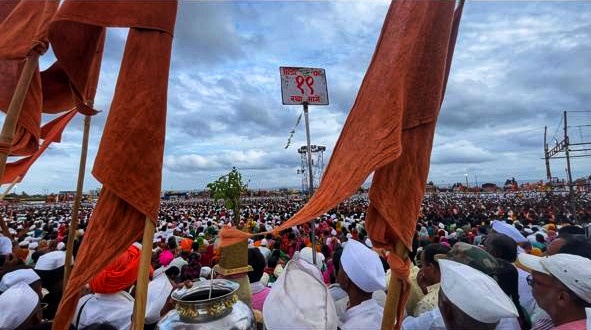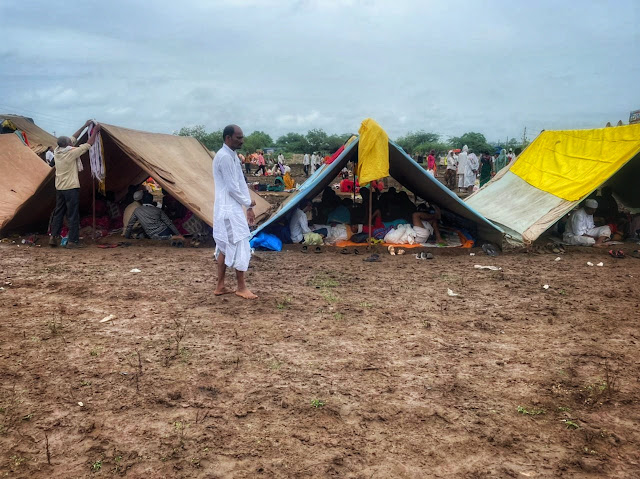Pandharpur Wari | Why do People Walk 250 KM to Visit this Holy Place?
About Pandharpur Wari
Pandharpur Wari (Dindi) which is
also named Ashadi Wari is an annual festival celebrated in the Pandharpur district
of Maharashtra, India. Pandharpur is the religious capital of Maharashtra. This festival is dedicated to Lord Vithoba, an incarnation of Lord Vishnu. Every year
this is celebrated in the Sanatan month of Ashadi Ekadashi. Many devotees come
together in a larger group and they start their 21 days marching to reach
Pandharpur, this process is called Wari and those who do Wari are called Warkaris. This Wari is also termed Dindi. The group of Warkaris units is Dindi. These 21 days of Dindi involve
carrying the Paduka of Saint in Palkhi, most notably of Saint Dnyaneshwar and
Saint Tukaram. This march starts from the shrine of Saint Tukaram place at Pune on day
one and ends at the shrine of Lord Vithoba in Pandharpur. This 21-day journey is
completed on foot and this is a distance of 250 km walk. This is one of those Maharashtras festivals where you get to
see many foreigners and high qualified people becoming part of this 21 days march on foot just to feel that Joy.
For the last two years, we have all suffered from a covid pandemic hence this festival was not celebrated. The main reason behind, this is the only festival of Maharashtra where you expect min of 15 lakh pilgrims to gather together and start their marching towards the Pandharpur. One fine day one of my close friends called me and said he is going to be a part of Pandharpur Wari this year. As I have heard, many old-ages take part in this Wari (festival), so I wanted to know more about these things. I started scrolling the social media sites to know more about Pandharpur Wari. The pictures and videos of the 2022 Wari (festival) started striking my mind and I dig deep into this topic. I never thought to find out the answer to my questions like what is Wari? Who is Warkari? Why is this a journey of 21 days? What is it where 15 lakh pilgrims come together and walk the distance of 250 km? and many more questions. These are a few questions that I asked my friend and guess what? he simply replied, you come to the Wari and you will get all the answers there after looking at the devotees. My curiosity to dig deep into this festival went high further. This year I got that opportunity to feel the essence of these vibes.
 |
| Palkhi of Saint Dnyaneshwar and Saint Tukaram is decorated with flowers |
I could not be a part of this 21-day marching but, yes I got a chance to be a part of this crowd for a while. Do you want to know how? no worries, I will tell you how you can feel about this festival too closely. Normally this is a part of the Ashadi procession. Ashadi Ekadashi is the day of Lord Vithoba and I rightly mentioned in history this marching starts from the Dehu Saint Tukarams shrine and Alandi Saint Dnyaneshwar shrine. The Wari (festival) is planned on the lunar day of the waning moon in the Hindu month of Jyeshta and reaches a day before Ashadi Ekadashi in Pandharpur. This becomes the cycle of 21 days with one day halt as per the tradition at some major point. This halt is the only time where some of the devotees go and take the blessings of both the Palkhis of Saint Tukaram and Saint Dnaneshwar. The route schedule of this marching starts from Dehu in Pune-Alandi-Pune-Saswad-Jejuri-value-and-tarragon-phalanx-Barad-nature-malsiras-Belapur-bhandishegaon-Makuhari-and then to Pandharpur. Though I have mentioned it is 21 days of marching, this marching takes halt everyday night and resumes early morning so there is no need to worry that you need to walk nonstop for 21 days.
 |
| Warkari's halt station on the way to Pandharpur |
It was the second day of Palkhi marching and the halt was at the Pune Nana Peth area. I got this chance and I traveled to Pune from Mumbai just to know the answers to some of my questions. My eagerness to know this tradition brought me to this place. I left early in the morning along with my wife and headed to Pune. The vibes were so positive throughout the journey. After 2 hours of drive, we reached Pune. The Palkhis of Saint Tukaram and Saint Dnyaneshwar was kept in the Lord Vitthals temple of Pune and there was a huge queue to take the blessings of those Palkhi. The environment was filled with positive emotions and it was giving me positive goosebumps. It was feeling like meeting our family members after a long time. yes, you heard me in the right way. It’s the same feeling as a baby longing for a mother's love after two years. It took us so long time for standing in a queue. We never felt tired despite standing in the queue for a long time.
 |
| Holy Paduka of Saint Dnyaneshwar which is kept in the Palkhi |
There were so many old-age along with youngster who was a part of this marching from the starting point of it. I wish I could also be a part of these 21 days but unfortunately, my office pulled me back. For me, this one day was no less than any happy moment of my life. I was overwhelmed. This is a kind of dream come true for me. Pandharpur Wari is a lifetime experience Full of Joy, Happiness, Devotion, Excitement, and learning. I would recommend you all to attend this at least once in your life. I don't know whether God will bless you or not but you will definitely learn a few of the positive things in life. This is a different world altogether; In this world, you will never feel people making the difference in rich people, poor people, or any caste. Everyone is the same in Lord's home.
 |
| Warkari's do the play with different activities while marching towards Lord Vithoba |
 |
| Ashadi Dindi is the crowd of a minimum of 15 lakh warkari's every year |
 |
| Tent stay of Warkari's which is put on the way during night halt |
Frequently asked Questions
Who had started the Wari??
Pandharpur Wari is a yatra to honor Lord Vithoba. The Wari tradition is more than 800 years now. According to the records available, this tradition was started by Vitthalpant, the father of Saint Dnyaneshwar, who began the Wari by marching to Pandharpur in the Hindu month of Ashadi Ekadashi. Later, the tradition of carrying Paduka of Saint was started by Saint Tukaram's youngest son Narayan Maharaj.
How is this Wari (Dindi) managed?
The concept of the Dindi was introduced by Haibatrao Baba. Many devotees group as per their own village comes together and form their individual group. Likewise, all village group forms the group and this registered group is allocated a number. This group joins the Dindi as per the number which is allotted to them. As you know there is one team leader who leads the group, the same applies to the Dindi group. They nominate one group member making their team leader who gives them all the details to avoid the mess. Few members carry the flag and banners of the respective group. Some of these Dindi walks in front of the Palkhi and some walk behind the Palkhi.
Who provides the food facilities to the Warkaris??
Meals and other facilities are provided by respective Dindi. There are so many people who sponsor the Dindi group. They all feel that this kind of serving to God is a kind of blessing to them and that's the reason people contribute to the respective Dindi. Along with the procession, this meal Seva is also provided to the nearby poor. No one is big or small is the tradition of Dindi. Apart from these sponsors if any of the Warkari feels to contribute some kind of donations in terms of food or money then it can also be done. Whatever people contribute is from the bottom of their hearts. As I rightly mentioned, the journey of the Palkhi is pre-determined along with the halt station and food break so that everything is managed so well by internal people only.
What if any medical emergencies come to the pilgrims during their 21 days marching to Pandharpur??
No worries, as there are 10-15 lakh pilgrims from young to old who participates in Dindi, I righty mentioned there are different people who sponsor the Dindi. These different people include the clinic, hospital, and nurses including government institutions who set up their free healthcare unit on the way of Marching, if in case any emergencies come then they can be treated free of cost to all. The government unit provides free sanitary napkins for women pilgrims during this procession. Some people massage the Warkaris legs because Marching is a journey of 250 km so in some cases, if cramps come in the legs then they are treated free of cost. These people are also treated without charging a single rupee.
Who can participate in the Dindi?
Starting from youngster to middle age or old age those who believe in god can participate in Dindi. There is no limit to the age group to be a part of the Dindi. Few people who cannot make time from their life, they can at least go and take the blessings of Palkhi wherever Palkhi halts. The one thing to keep in mind whatever you are doing do it from your heart is the only thumb rule.
What about the washroom facility throughout the Marching of 250 km?
Of course, this is one of the most frequently asked questions. I
would like to inform you that there is a portable washroom placed on the marching
road of Pandharpur. I kept mentioning the management of Dindi is so well, that you
will not even feel that you are running a shortage of anything. Running
washrooms are there to help you out throughout the day.
Where does Warkari stay during the night's halt?
During the night halt, the Palkhis are kept in the respective temple whereas the Warkaris pitch the tents and stay in them. Dindi is the perfect example of how things are managed if the group is larger, isn't it? I was wondering to see such a large group is managed on their own along with their stay.
Do not litter the area around you.


No comments:
Post a Comment